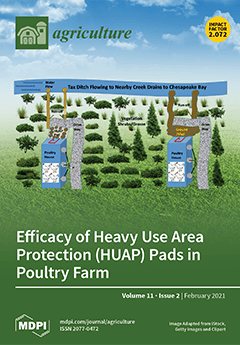The development of organic farming as a result of increasing consumer preference for organic food has led to the development and registration of new pest-control products for certified organic production. In this study, the effects of three biocontrol products containing spores and mycelium
[...] Read more.
The development of organic farming as a result of increasing consumer preference for organic food has led to the development and registration of new pest-control products for certified organic production. In this study, the effects of three biocontrol products containing spores and mycelium of
Arthrobotrys oligospora—Artis
®,
Beauveria bassiana—Bora
®, and
Coniothyrium minitans—Öko-ni
® were tested on four basil (
Ocimum basilicum L.) cultivars: ‘Aromat de Buzau’, ‘Serafim’, ‘Macedon’ and ‘Cuisoare’. The application of Öko-ni
® increased basil yields by 8% relative to Control. The application of Bora
® increased chlorophyll content of basil leaves by 2% and the activity of photosynthesis by 66% relative to the Control. Basil essential oil (EO) content was increased by 18% with the application of Artis
® and by 34% with the application of Bora
® and Öko-ni
®, respectively. The content of phenolic compounds analyzed by HPLC varied; caffeic acid concentration was higher in the plants treated with Öko-ni
®, hyperoside, isoquercitrin and rutin concentrations were higher in those treated with Artis
®, while the quercitrin content was higher in Bora
®-treated plants. The two main EO constituents that were identified were linalool and methyl chavicol in ‘Aromat de Buzau’, linalool and eugenol in ‘Serafim’, neral and geranial in ‘Macedon’, also linalool and eugenol in ‘Cuisoare’. The investigated myco-biocontrol products had positive effects on basil fresh biomass and EO content and also influenced the content of phenolic compounds.
Full article





